The key metrics we track for our annual Space Symposium are looking better than ever. We are sold out of exhibit space, ahead of plan in sponsorships, ahead of forecast in advance registrations and have confirmed our largest number of speakers ever.

There’s a bumper crop of off-agenda meetings, ranging from the Aerospace States Association to the Coalition for Space Exploration, the Hosted Payloads Alliance, the Space Generation Advisory Council and more. Commercial, entrepreneurial and international participation, which have been on a steady upward trend for the past eight years, continues to look particularly strong. Significant international participation is expected from Japan, Canada, China, France and other countries—probably 25 or 30 countries when all is said and done.
But that’s not to say there won’t be challenges. Historically, the participation of key U.S. government agencies like the Air Force, NASA, NOAA, the NRO and others has been a fundamental strength of the Space Symposium. Yet nonsensical, politically motivated, hard-to-fathom events like government shutdowns, sequestration and a highly politicized, witch-hunt mentality surrounding government travel have made the past two years surrealistically challenging for us, in a frustrating, doesn’t-pass-the-common-sense-test kind of fashion.
The Space Foundation has been able to overcome those challenges, and there are some important positives for us heading into the run-up to the greatest Space event on Earth:
• First, unlike 2012 and 2013, the specter of a nationwide federal government shutdown no longer hangs over us like a Sword of Damocles.
• Second, federal agencies know what their budgets are for 2014. Some, like NASA, actually have more money in their budgets than they expected.
But, whether they like their budgets or not, at least they have a budget. This makes planning for critically important meetings like the
Space Symposium at least possible.
• Third, government agencies have had a year to adapt to new travel regulations triggered by OMB’s over reaction to internal government (read GSA
and IRS) conference scandals. No matter how draconian or illogical an agency’s current travel restrictions may be, people at least now know how to
navigate them.
Despite all these positive trends and indicators, we know that we cannot expect government to always function in a common-sense way, and we know that the politics of perception plays a much more significant role than it should. We know that many of our government colleagues who can most benefit from attending the Space Symposium will confront internal gatekeepers of the arch-conservative accounting and legal tribes—those who, even in the best of circumstances, will always look for a reason to say “no” when they should be looking for a way to say “yes.”
To help with those conversations, here are a few direct and factual answers to the questions that gatekeepers sometimes have about the Space Symposium:

#1. Optics. “Why is the Space Symposium at the Broadmoor? If only the conference venue weren’t so nice.
One of the big issues for me in this question is the assumption that government employees are only doing their job if they are suffering. Clearly this wouldn’t be a question if the conference were held in a sweltering hot canvas tent in the middle of a third world desert. We ought to all reject this notion.
The simple answer is that the Space Symposium is in Colorado Springs because one of the world’s largest and most important space agencies—U.S. Air Force Space Command—is here. While the Symposium is an international phenomenon that cuts across all sectors of the space enterprise, foundational to that enterprise is AFSPC, the 800-pound gorilla of the global space community. Virtually everyone who has anything to do with space needs to keep current and connected to AFSPC. That is why the Space Symposium is here.
Understand that, and understand that the Space Symposium attracts about 9,000 people, and you understand that The Broadmoor is the only venue in the city that has the physical infrastructure to host the event. That infrastructure needs to include scores of meeting rooms, theater seating for 1,800 people at a time and nearly 200,000 square feet of total conference space. There are no other facilities in the region with that capacity. Period.
Beyond that, it is important to understand that the vast majority of attendees don’t actually stay at The Broadmoor; 750 rooms versus 9,000 participants—do the math. There are 10 official conference hotels, most are in the mid-range pricing tier, and most offer rooms at the official government per diem rate.
#2. Cost. Wouldn’t it be cheaper to go to other conferences?
No. It simply wouldn’t. On so many levels.
First, there is no other conference that delivers so much value for the government. Because of the vast attendance by both national and international space community leaders, it offers a more target-rich environment for networking and meetings than the next half-dozen space conferences combined. Travel once to the Space Symposium, or travel six, eight or ten times to lesser events. Which costs the government less? The Space Symposium, obviously.
Second, the Space Symposium is actually a pretty cheap conference for government to attend. When budget axes started swinging and travel restrictions started popping out of the ground like Whack-A-Mole, the Space Foundation—very conscious of the challenges faced by our government customers—rolled back our government pricing to 2010 levels. The all-inclusive government registration rate of just $790 is far less than our actual per-person cost of putting on the event, and is heavily offset by fees paid by exhibitors, sponsors and other registrants and guests. Government employees can attend the technical program for just $300.
Third, the Space Symposium is a lot cheaper for our government customers to travel to than other conferences. While you would have to attend a half-dozen other conferences to get the benefits you get from attending the Space Symposium, we could, for comparison purposes, look at the annual International Astronautical Conference (IAC) as a near-peer—despite it attracting a more narrowly focused audience and usually only one-third as many participants. The IAC was in Beijing last September. At this writing, a round trip airline ticket from Washington, D.C. to Beijing is about $1,639 and the average hotel room rate in Beijing is $266. For Colorado Springs those numbers are $350 and $115, respectively.
#3. Let’s just give up. Well then, we’re going to save money by just not going to any conferences!

The data suggests that if you just stay home, you will drive your agency’s travel costs up. It’s just that those costs will show up as program expense rather than overhead.
One of the things we learned last year, based on a single government agency that did not attend, was that necessary business and program meetings that normally take place at the Space Symposium often have to be rescheduled as stand-alone meetings throughout the rest of the year. One customer told us that they had to schedule at least 60 other, individual trips throughout the rest of the year to make up for meetings they would normally schedule during the Space Symposium. And those individually scheduled meetings are charged back to the government contract. It is far, far cheaper for a government agency to participate in the Symposium than not.
Think of it this way: most CEO-level company executives, and their senior government counterparts, schedule, on average, anywhere from 25 to 75 meetings during the Space Symposium. (That’s not a typo. A 14-hour day schedule of 15-minute power meetings is not uncommon. Some executives take as many as 90 meetings during the event.) How expensive would it be to conduct that many meetings in any other environment?
Of course, those are just sort of the nuts and bolts financial mechanics of why participation in the Space Symposium is so very valuable for the government. The larger issue is that which has been so well articulated by the U.S. Travel Association and others—the amazing power of ideas and collaboration that takes place when people come together face to face to meet in a conference or symposium environment.
We fundamentally believe that the communication and information-sharing that takes place during the Space Symposium makes us all better as an industry, as a community and as individuals. Whether we work for government, industry, academia or non-governmental organizations—our participation in the Space Symposium makes us better and more effective as individuals, as professionals and as employees of our respective organizations. Collectively, we make our organizations better, too.
The exploration, development and utilization of space, whether for civil, commercial, national security, homeland defense, entrepreneurial, academic, scientific or other purposes—is profoundly a team sport. The annual “team meeting” is the Space Symposium—and you cannot play well at a skill position if you do not attend.
All the indicators suggest that the 30th Space Symposium is going to be our best event ever.
The View From Here is that it is also government’s best bargain ever. And we look forward to seeing all of you here May 19-22.
By the way, if you haven’t attended the Space Symposium lately, please visit our website for all the details about new programs such as our day long classified session on Space Situational Awareness, our new Technical Track sessions of paper presentations and technical panel discussions, our trail blazing New Generation Space Leaders program, Cyber 1.4 and more!
The Space Symposium infosite is located at http://www.spacesymposium.org/

About the author
Named chief executive officer of the Space Foundation in 2001, Elliot Pulham leads a premier team of space and education professionals providing services to educators and students, government officials, news media and the space industry around the world. He is widely quoted by national, international and trade media in coverage of space activities and space-related issues.
Prior to joining the Space Foundation, he was senior manager of public relations, employee communication and advertising for all space programs of Boeing, serving as spokesperson at the Kennedy Space Center for the Magellan, Galileo and Ulysses interplanetary missions, among others. He is a recipient of the coveted Silver Anvil Award from the Public Relations Society of America—the profession’s highest honor.
In 2003, the Rotary National Awards for Space Achievement Foundation presented him with the coveted Space Communicator Award, an honor he shares with the late legendary CBS News Anchor Walter Cronkite and former CNN News Anchor Miles O’Brien. Pulham is chairman of the Hawaii Aerospace Advisory Committee, a former Air Force Civic Leader and advisor to the Chief of Staff and Secretary of the Air Force and a recipient of the U.S. Air Force Distinguished Public Service Medal. He serves on the editorial board of New Space Journal.

